When someone performs an online search, they want an answer fast. And search engines want to give them those answers with zero to few hoops to jump through.
With SERPs, we’re not looking at a riddle of the sphinx situation. Quite the opposite.
Search engines like Google prioritize relevant results. That’s why you’ll occasionally see SERP features like featured snippets and knowledge panels for certain search queries. Sometimes, users can get the answers they need without even leaving the results page.
In short, search engines want to be helpful to their users. Marketers use CTR to determine what is useful and what isn’t. That’s why a high click-through rate is so important: relevancy.
Keep reading to learn about CTR for PPC and SEO and why improving your score will benefit your business.
Why You Need to Care About CTR
Search engines care about CTR, and so should you. Point blank.
Here’s a refresher in case you need it: click-through rate is the ratio of users who clicked on a link compared to the total number of users who viewed that page.
The formula to calculate CTR is total clicks divided by total impressions. Multiply that by one hundred to get your percentage.
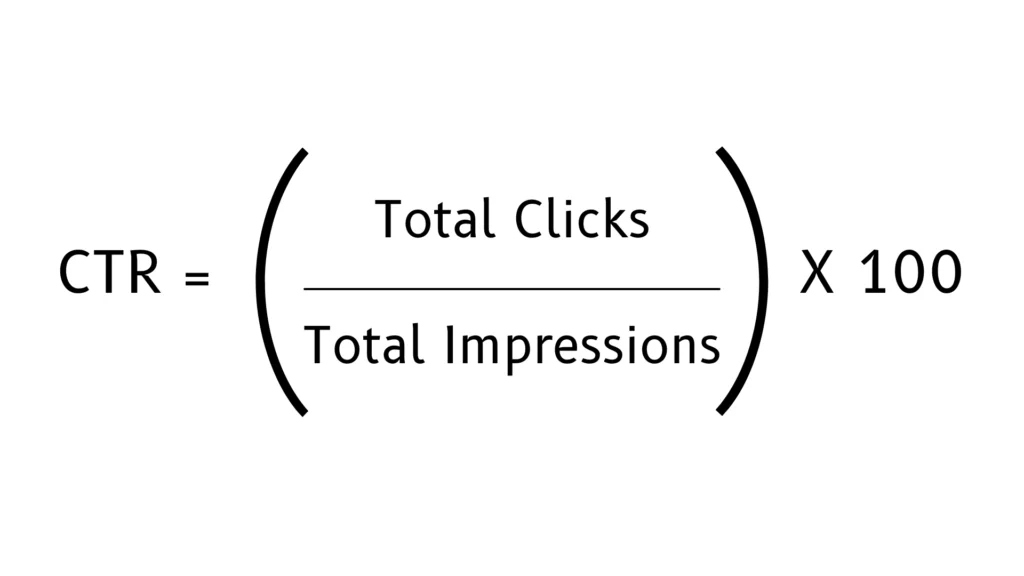
If you’re already using Google Ads and Google Search Console, you’ll be able to view this data in your dashboard.
A high CTR is good because it means that a large number of people who viewed your link (ad, web page, etc.) clicked on it.
Remember when we talked about Google liking relevancy? That’s why we care about CTR. We don’t put content out into the ether for people to ignore it completely.
Of course, things are a little different when we talk about CTR for PPC vs. CTR for SEO, which we’ll get into. Regardless of what type of marketing strategy you are focusing on, you should be paying attention to the clicks vs. impressions ratio.
Whether you’re looking to improve your ad conversions or get more organic traffic to your site, we highly recommend making CTR a priority. Understanding your current click-through rate will give you a good idea of how you’re doing and where you can improve.
Let’s break down CTR for paid ads and organic content.
Click-Through Rate for PPC Marketing
CTR is one of the most important metrics to pay attention to if you are implementing paid customer acquisition strategies. And maintaining a high CTR is vital.
Remember that word “relevancy”? It all comes back to that.
When you create an ad to sell a product or advertise a service, you are doing it with conversions in mind. After all, the pay-per-click model means you pay for every click on your ads, regardless of what happens next.
You want your ads to be relevant to your targeted audience; otherwise, you’re just throwing money away.
Search engines want your ads to be relevant, too, because they’re the ones making money off those clicks. The more clicks, the more money.
Your CTR will let you (and search engines) know how relevant your ads are.
If you have a high CTR, that’s good: users find your content relevant to their search queries. If you have a low CTR, users find your ads to be less relevant.
There could be several reasons for a low CTR, so you’ll need to do some research to see how you can improve your ad. It could be that you’re targeting the wrong keywords, or your language isn’t conveying the right message.
Another reason to shoot for high CTRs is your Quality Score. Your Quality Score refers to the quality of your ads, keywords, and landing pages. Google ranks your quality on a scale of one to ten, with one being the lowest and ten the highest.
A high score indicates that your ads and landing pages are useful to consumers. You can check your score by looking at your keywords report.
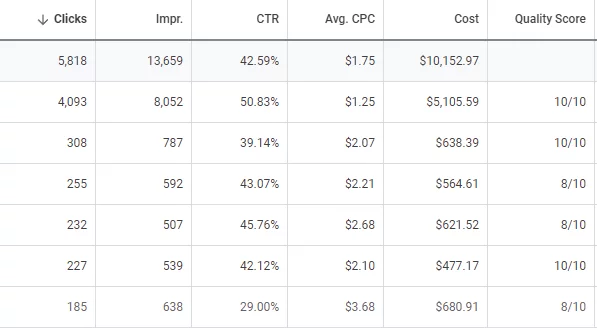
Quality Scores influence the cost and effectiveness of your paid search campaigns. Google rewards relevancy with higher ad ranking and lower costs. The higher your Quality Score, the lower your cost per conversion.
Essentially, high Quality Scores will allow you to maintain or improve your ad positions for less money.
High CTR and better ad positions will allow you to drive the highest possible number of people to your page, which is the best we can hope for.
What Is a Good CTR for PPC?
We keep talking about high/good click-through rates, but what does that mean? What qualifies as a good CTR for paid ads?
There isn’t a straightforward answer or one particular number to aim for. The truth is, what qualifies as a “good” CTR is dependent on many factors.
A CTR score is relative to your industry, your keyword bids, your target audience, and individual campaigns. Branded keywords tend to have a higher CTR than broad, unbranded ones.
There will also be a difference in performance between ads displayed on the search network vs. the display network. Text-based ads displayed at the top of SERPs tend to perform better than image-based ads (banner ads) because there is more user intent.
Essentially, a good CTR for one ad may be an unimpressive number for another type of campaign. The best thing you can do is research average click-through rates for your particular industry and go from there.
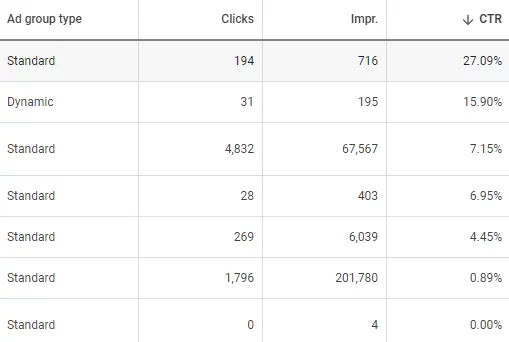
When a Low CTR is Acceptable
Until now, we’ve discussed why a high CTR is good for business. But there are times when a low CTR is okay.
As important as CTR is, it’s not the only metric you should look at. Your conversion rate is just as important, especially since you’re likely using ads to drive your business.
Don’t miss the forest for the trees. If your CTR is high, but your conversion rates are low, there’s a problem with your ad.
In addition to optimizing your ads for CTR, you need to optimize your campaigns for cost. You will need to consider your advertising budget for PPC ads.
Consider these points:
- You are paying every time someone clicks on your ad, regardless if they convert.
- The more clicks, the more you’re spending on ads.
- If you have high clicks but low conversions, the cost per lead gets expensive.
- Some keywords are priced so high that you won’t turn a profit even if those clicks lead to conversions.
In short: if you are only focusing on clicks, you’re spending a lot of money without actually bringing in more business. Might as well throw money away.
How to Get Good CTRs on Your Ads
The solution to successful PPC campaigns isn’t to ensure your CTR rates are high across the board. You specifically want high click-through rates on keywords that are relevant and affordable.
To get good click-through rates in PPC, you need to focus on these three aspects:
- Keyword choices and intent
- Ad copy
- Audience
Keywords
When it comes to keywords, there are plenty of great PPC tools available to help you increase your campaign’s ROI. From Google’s free Keyword Planner to paid PPC tools, if you’re not getting keyword help for your campaigns, you’re essentially going in blind.
Additionally, familiarize yourself with negative keywords and how you should use them in your PPC campaign.
Copy
The right ad copy language will be vital to the success of your ad. Your keyword strategy may be perfect, but if your ad shows up in SERP and the copy isn’t appealing, who’s going to click on that ad?
Get rid of the formulaic blurbs. Use all the space you have at your disposal. And don’t forget that CTA!
Audience
If you’re going to go through all this hassle to create the right ads, you want to make sure the right people are seeing them; otherwise, you’ll never improve your CTR. You also need to consider the devices, locations, and timezones of your users.
Get rid of the formulaic blurbs. Use all the space you have at your disposal. And don’t forget that CTA!
The biggest takeaway: There are many ways to improve your CTR for PPC, and many of them are going to be industry-specific. Testing will be your friend, but make sure you only test a single variable at a time, so you know what’s helping or hurting your CTR.
Click-Through Rate for SEO Marketing
While CTR may be most recognized as an integral part of PPC campaigns, it’s also an important factor in your SEO marketing strategy.
The click-through rate will reflect the performance of your pages in the SERPs.
The calculation for organic CTR is organic clicks divided by impressions.
Unlike PPC, SEO marketing focuses on users finding your content organically. So, while you’re not paying for clicks, you still need to know how many people that come in contact with your content are actually clicking on it.
Not only do you want your pages to rank high in the search engines, but you also want people to come to your site.
If you’re selling a product or service, you want them to enter your content marketing funnel. Lead magnets will help, but you need them to click on your website first, you know?
By paying attention to the click-through rates of your ranking pages, you can see how many users visited those pages from the overall SERP visitors.
Just to reiterate: rankings are good, but you don’t want to stop there. What’s the point of ranking high if nobody is taking action?
Now, when it comes to CTR for SEO, Google says the algorithm doesn’t use CTR as a ranking factor. This is a hotly debated topic, but as it stands, there is no definitive proof.
The exception (at least according to Google) is that Google uses clicks for personalization, but they play no part in ranking.
How to Check Your SEO CTRs
The most common and easiest way to check your click-through rate is in Google Search Console.
When you look at the performance report, you will see the average CTR values for all pages and the ranking queries. For the most relevant results, you will want to specify the page and query.
How to view average CTR for individual pages:
- Under Performance, select search results on the left-hand side
- Choose the “average CTR” metric under the Performance chart
- Define date range if needed
- Select “Pages”
- From here, you can view individual pages and queries
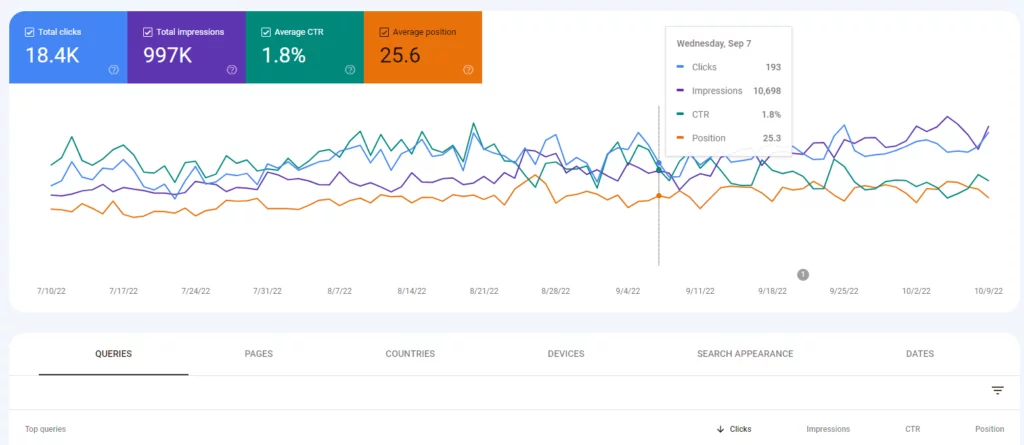
What Affects CTR for Organic Search Results?
Several factors influence click-through rates for organic content. These include but are not limited to:
- Ranking position
- SERP features
- Type of query
- Presence of PPC ads
The ranking position plays the most important role in influencing CTR. The higher you appear in the rankings, the more likely a user will click on your page.
Studies have found that the first three results get the most views – in fact, they get more clicks than the rest of the top ten combined.
The average CTR for the number one position is 28.5%. The second position drops down to 15.7%, and the third position, 11%.
If you appear in the 10th position, you can expect about 2.5% of users to click on your link. Beyond the top ten? You can expect a much smaller average CTR.
Another thing to consider regarding ranking and CTR is SERP features: your web page isn’t always going to compete with other organic search results.
Depending on the search query, you may also have to compete with featured snippets (which can get a 0% CTR, by the way) and the knowledge panel, in addition to ads, images, videos, etc.
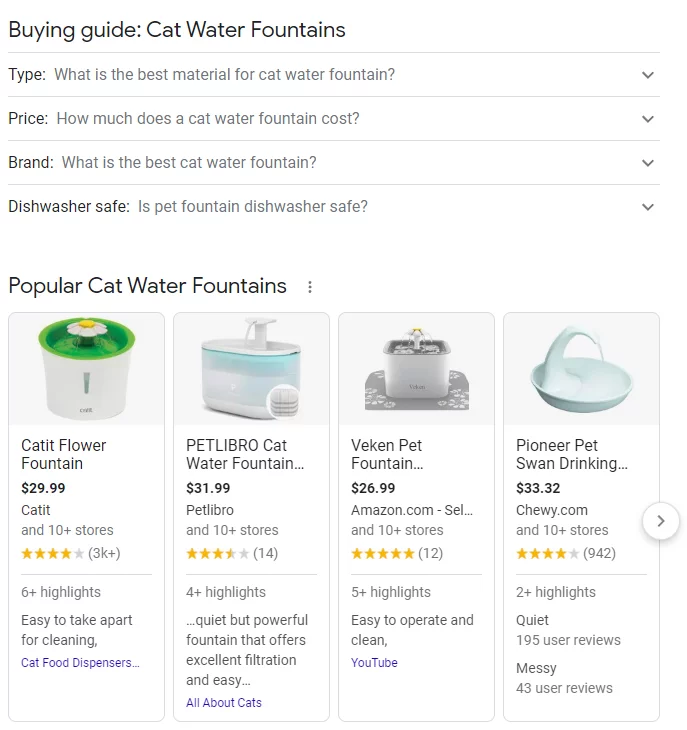
If people get the answers they need without leaving the results page, they don’t need to click on anything else.
One way you can help improve your CTR is to study the SERP results and use the information from your analysis to your advantage.
How to Improve Your CTR for Organic Search Results
Like with PPC ads, there are various ways you can work to improve the click-through rate on your web pages. To be transparent, we recommend these improvements to all our SEO clients for their content.
Here are a few ways to boost your CTR for organic search. For more information on how to improve your overall SEO, check out our complete technical SEO checklist.
1.) Improve Your Title Tags
Copywriting can be hard. But when a title is the only thing users see in the SERPs, you have to make it shine. So bust out the creativity and focus on improving your titles.
Here are some tips:
- Avoid heavy title tags (be concise)
- Try a numbered list
- Utilize brackets
- Include relevant keywords
- Experiment with headlines
2.) Optimize Meta Descriptions
Like with title tags, meta descriptions will be one of the only things users see when your page pops up in search results, so make it count.
Your snippet should be informative and attract users to click through and learn more. They should be original for every page and include a call to action.
3.) Create Descriptive URLs
Believe it or not, descriptive URLs matter.
People are much more inclined to click on a link that looks like lseo.com/click-through-rate-understanding-ctr-for-ppc-seo than lseo.com/post=570/ab123?.
Rather than letting your site generate a random URL, always optimize the slug for every page. For example, your slug should be short but descriptive, contain your focus keyword, and stylistically separate every word with hyphens.
Key takeaway: If you want to improve your organic content CTR, you should also work to improve your ranking. SEO will get you there. Trust the process.
Let’s Improve Your Click-Through Rate Together
PPC and SEO marketing aren’t always straightforward, especially for anyone new to implementing such strategies. The good news is we already have the knowledge, so you don’t have to stress about it.
If your website performance isn’t where you want it to be and your ads are falling short, LSEO can help. We have a team of experts who can help improve your PPC and SEO click-through rates and increase your leads.
Let us help you take your business to the next level. Contact us today!
